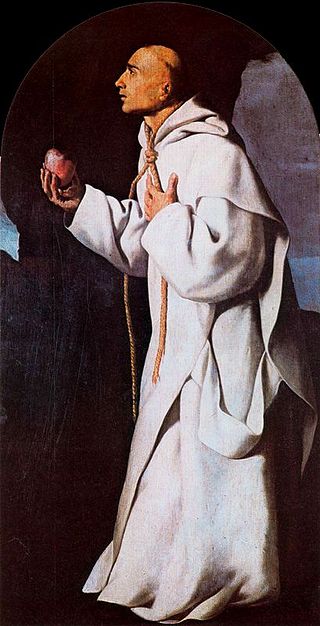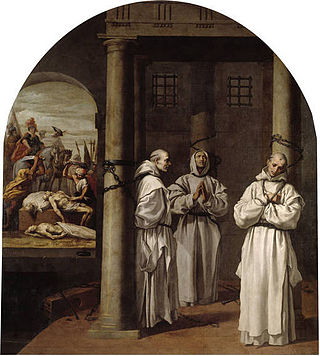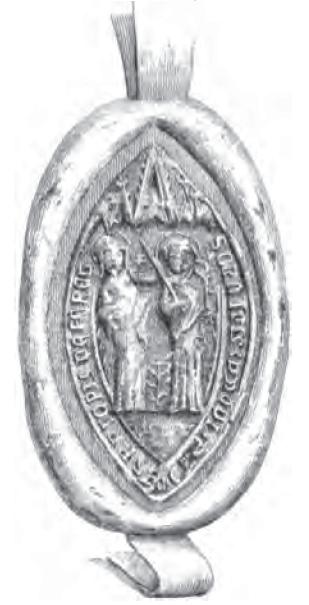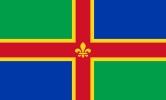Related Research Articles

The Carthusians, also known as the Order of Carthusians, are a Latin enclosed religious order of the Catholic Church. The order was founded by Bruno of Cologne in 1084 and includes both monks and nuns. The order has its own rule, called the Statutes, and their life combines both eremitical and cenobitic monasticism. The motto of the Carthusians is Stat crux dum volvitur orbis, Latin for 'The Cross is steady while the world turns'. The Carthusians retain a unique form of liturgy known as the Carthusian Rite.

The dissolution of the monasteries, occasionally referred to as the suppression of the monasteries, was the set of administrative and legal processes between 1536 and 1541, by which Henry VIII disbanded Catholic monasteries, priories, convents, and friaries in England, Wales, and Ireland; seized their wealth; disposed of their assets, and provided for their former personnel and functions.

The London Charterhouse is a historic complex of buildings in Clerkenwell, London, dating to the 14th century. It occupies land to the north of Charterhouse Square, and lies within the London Borough of Islington. It was originally built a Carthusian priory, founded in 1371 on the site of a Black Death burial ground. Following the priory's dissolution in 1537, it was rebuilt from 1545 onwards to become one of the great courtyard houses of Tudor London. In 1611, the property was bought by Thomas Sutton, a businessman and "the wealthiest commoner in England", who established a school for the young and an almshouse for the old. The almshouse remains in occupation today, while the school was re-located in 1872 to Godalming, Surrey.

Augustine Webster, O.Cart was an English Catholic martyr. He was the prior of Our Lady of Melwood, a Carthusian house at Epworth, on the Isle of Axholme, in north Lincolnshire, in 1531. His feast day is 4 May.

John Houghton, OCart was a Catholic priest of the Carthusian order and the first martyr to die as a result of the Act of Supremacy by King Henry VIII of England. He was also the first of the Carthusians to die as a martyr. As one of the Carthusian Martyrs of London he is among the Forty Martyrs of England and Wales.

Mount Grace Priory is a monastery in the parish of East Harlsey, North Yorkshire, England. Set in woodlands within the North York Moors National Park, it is represented today by the best preserved and most accessible ruins among the nine houses of the Carthusian Order, which existed in England in the Middle Ages and were known as charterhouses.
Maurice Chauncy was an English Catholic priest and Carthusian monk.

Pluscarden Abbey is a Catholic Benedictine monastery in the glen of the Black Burn, six miles southwest of Elgin, Moray, Scotland. It was founded in 1230 by Alexander II for the Valliscaulian Order.

John Rochester was an English Carthusian choir monk and martyr. He was hanged at York for refusing to concede King Henry VIII's supremacy over the church.

William Exmew, O.Cart was an English Catholic priest and Carthusian hermit. He was hanged, drawn, and quartered at Tyburn and is honoured as a martyr by the Catholic Church. Exmew and his brother Carthusian martyrs were beatified by Pope Leo XIII on 9 December 1886.

Humphrey Middlemore, OCart was an English Catholic priest and Carthusian hermit, who was executed for treason during the Tudor period. He is considered a martyr by the Catholic Church, and, along with other members of his religious order to meet that fate, was beatified by Pope Leo XIII on 9 December 1886.

Sebastian Newdigate, O.Cart was the seventh child of John Newdigate, Sergeant-at-law. He spent his early life at court, and later became a Carthusian monk. He was executed for treason on 19 June 1535 for his refusal to accept Henry VIII's assumption of supremacy over the Church in England. His death was considered a martyrdom, and he was beatified by the Catholic Church.

The Carthusian Martyrs of London were the monks of the London Charterhouse, the monastery of the Carthusian Order in the City of London who were put to death by the English state in a period lasting from the 4 May 1535 until the 20 September 1537. The method of execution was hanging, disembowelling while still alive and then quartering. Others were imprisoned and left to starve to death. The group also includes two monks who were brought to that house from the Charterhouses of Beauvale and Axholme and similarly dealt with. The total was 18 men, all of whom have been formally recognized by the Catholic Church as martyrs.

Beauvale Priory was a Carthusian monastery in Beauvale, Nottinghamshire. It is a scheduled ancient monument.

Perth Charterhouse or Perth Priory, known in Latin as Domus Vallis Virtutis, was a monastic house of Carthusian monks based at Perth, Scotland. It was the only Carthusian house ever to be established in the Kingdom of Scotland, and one of the last non-mendicant houses to be founded in the kingdom. The traditional founding date of the house is 1429. Formal suppression of the house came in 1569, though this was not actualised until 1602.
Catley Priory was a monastic house in Walcott, Lincolnshire, England.

Monks Kirby Priory was a Benedictine priory established in 1077 in Monks Kirby, Warwickshire, England. The priory was suppressed in 1415 when its estates and revenues were given to the Carthusian priory of Axholme in Lincolnshire, in whose possession they continued until the Reformation. Remains of the priory form part of Monks Kirby village church today.

The Charterhouse was a Carthusian monastery and almshouse in Kingston upon Hull, England, built just outside the town's walls. The hospital building survived the Dissolution of the Monasteries; the priory was destroyed in 1538. The structure of the hospital was destroyed before the first siege of Hull during the English Civil War. A replacement was built in 1645, which was replaced again in 1780; the buildings function as an almshouse with an attached chapel, and remain in use to the present day (2012).

The Carthusian martyrs are those members of the Carthusian monastic order who have been persecuted and killed because of their Christian faith and their adherence to the Catholic religion. As an enclosed order the Carthusians do not, on principle, put forward causes for their members, though causes have been promoted by others on their behalf.
References
- 1 2 3 4 Page, William, ed. (1 January 1906). "Houses of Carthusian monks: The priory of Axholme". A History of the County of Lincoln. Victoria County History. Vol. 2. pp. 158–160. ISBN 9780712910453 . Retrieved 21 July 2013– via British History online.
- ↑ Historic England. "Axholme Priory (60927)". Research records (formerly PastScape). Retrieved 21 June 2013.
- Lincolnshire Architectural & Archaeological Society
- Glyn Coppack and Mick Aston, nd: Christ's Poor Men - the Carthusians in England ISBN 0-7524-1961-7
53°30′27″N0°47′10″W / 53.5075°N 0.7861°W

